










Imphal, May 22
In fresh violence in Manipur, two houses were torched by a mob in Imphal East district after two armed miscreants forced people to shut their shops on Monday afternoon, police officials said.
However, no casualty was reported due to the arson.
The mob also beat up one of the miscreants while the other managed to flee. The two were taken into custody.
Armymen deployed in the area who rushed to the scene used force and fired teargas shells to disperse the mob resulting in minor injuries to a few people.
Locals protested the incident by burning tyres on the road.
Following the incident, curfew hours in Imphal East district which had earlier been relaxed were tightened.
NN
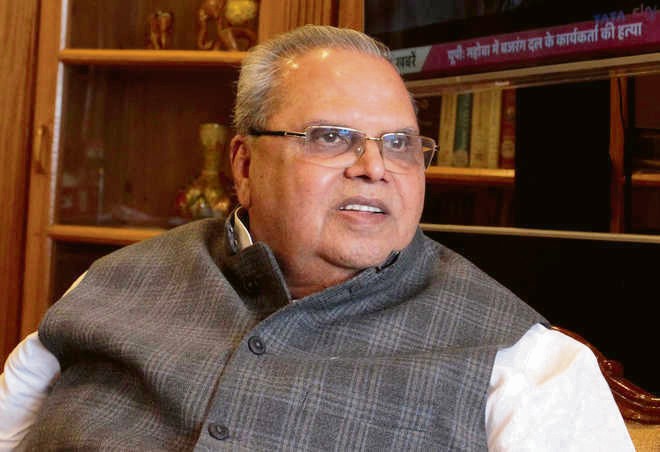
Jaipur, May 22
Former Jammu and Kashmir governor Satyapal Malik again attacked the government over the Pulwama attack issue, saying the 2019 Lok Sabha elections were “fought on the bodies of our soldiers”, and the then home minster would have to resign had there been a probe into the incident.
He claimed he had informed Prime Minister Narendra Modi about the attack just after the incident but “he told me to keep quiet”.
“Elections (Lok Sabha 2019) were fought on the bodies of our soldiers and no investigation was done. Had an inquiry been done, the then home minister (Rajnath Singh) would have to resign. Many officers would have been jailed and there would have been a huge controversy,” Malik said at an event in Bansur of Alwar district.
Malik has been vocal about the issues related to Jammu and Kashmir where he was the governor before the state was divided into the two Union Territories of Ladakh and Jammu and Kashmir.
He said during the event on Sunday that when the Pulwama attacked happened on February 14, 2019, the prime minister was in a shooting at the Jim Corbett National Park.
“When he came out from there I got a call (from him). I told him that our soldiers have been killed and they got killed by our mistake. He told me to keep quiet,” Malik said.
Malik was recently questioned by the CBI over his claim that he was offered Rs 300 crore as bribe to clear files related to an insurance scheme during his tenure as Jammu and Kashmir governor between August 23, 2018 and October 30, 2019.
He also attacked Prime Minister Narendra Modi over the Adani issue. Malik said Adani has created much wealth in just three years, and asked those present if they had been able to increase their wealth.
He said Congress leader Rahul Gandhi told Parliament that Adani had got Rs 20,000 crore and asked the government ‘where did it come from’.
“The prime minister could not answer. He talked for two days but could not answer one thing because he had no answer and I am saying that it is all his money,” Malik said.
“They loot from their chief ministers and give it to Adani and he does business and he is sure that it is my money,” Malik said.
“I was in Goa, I complained about the corruption of the chief minister there to the prime minister and the result was that I was removed as governor and the CM continued on the post. That’s why I am sure that they do corruption right under his nose and has a share in it and the entire share goes to Adani,” Malik said.
He urged people to change the government. “Because if you vote from them again, you will not get a chance to vote thereafter. After this he will not let you vote, he will say that every time only I win, then why spend on elections,” he said.

The heritage centre has a wall of murals of women officers. On display are embossed pictures of Air Marshal Padma Bandopadhyay, the first woman to be promoted to the rank; Sqn Ldr Cheryl Dutta, first to fly a helicopter; Sqn Ldr Priya Nalgudwar, first to fly a transport aircraft; and Gp Capt Shailza Dhami, first to command a combat unit. The first batch of woman officers to fly fighter aircraft is in the middle. tribune photos: Pradeep Tiwari
Bhartesh Singh Thakur
On a fine Sunday morning in early 2021, then Punjab Governor and Chandigarh Administrator VP Singh Badnore called Group Captain PS Lamba to his official residence. Lamba had recently set up a three-storey Indian Air Force (IAF) museum in Thiruvananthapuram, Kerala. Badnore took him to the iconic Press Building in Sector 18, Chandigarh, which was India’s first glass façade structure. “He showed me the space and asked whether I could set up an IAF museum. I agreed,” says Group Captain Lamba. Designed by English architect Edwin Maxwell Fry and constructed in 1953, Press Building is one of the oldest constructions in Chandigarh.
“By the evening, Badnore had telephoned Raksha Mantri Rajnath Singh about the proposal,” reveals Lamba.
Air Chief Marshal VR Chaudhari, who was then Vice Chief of Air Staff, came for the signing of the Agreed-In-Principle document with the Chandigarh Administration on June 27, 2021. When the MoU was signed on June 3, 2022, Air Chief Marshal Chaudhari was present along with UT Administrator Banwarilal Purohit. He gifted a replica of an aircraft propeller as the first artefact of the IAF Heritage Centre. The propeller, by its rotation, provides forward pull to an aircraft. The gift was symbolic.
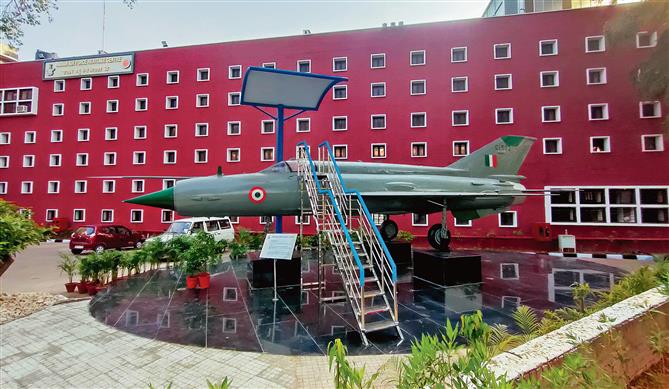
It was decided that the IAF will provide artefacts, simulators, aircraft, aircraft models and murals while the Chandigarh Tourism Department would manage the centre.
“From September 2022 onwards, we started the job. The murals were outsourced. It took eight months for the overall completion. We trained the guides for four months. The history department of the Ministry of Defence cleared the information to be displayed,” says Lamba, who was made the Project Director of the centre. His term ended on May 13, but he has been asked to keep monitoring the functioning of the centre.
Rajnath Singh inaugurated the IAF Heritage Centre last week. He termed it a testament to the courage and dedication of all those who have served in the IAF, a tribute to their sacrifice and a reminder of their invaluable contribution.Advertisement
A feel of the real thing
Built at a cost of Rs 2.75 crore, the Chandigarh centre is bigger and has more aircraft than the other IAF museums at Palam (Delhi) and Thiruvananthapuram. Two cockpits, five aircraft, and four simulators are parked here. “People can feel an aircraft. They can see which buttons are to be pressed for launching bombs and rockets, how to see speed, how to change radio frequency, how to see the altitude and compass. One doesn’t get such exposure of an aircraft elsewhere,” Lamba points out.
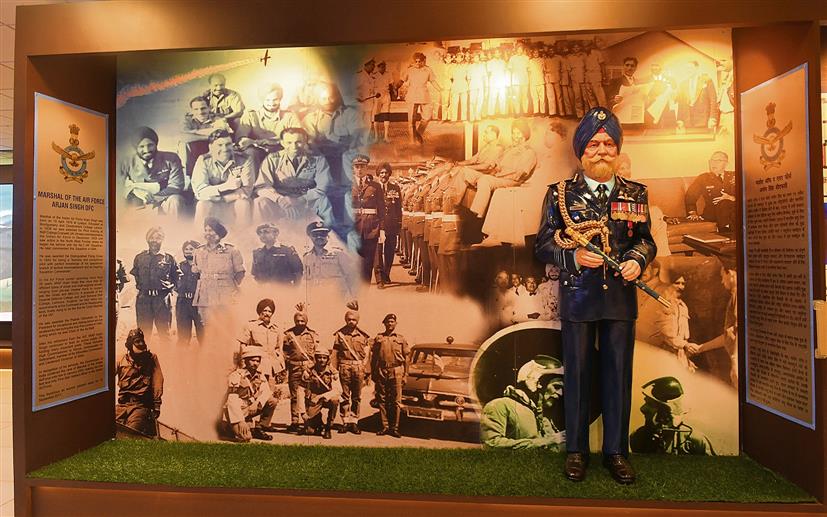
Advertisementhttps://f57f5b594b1f9058bcb44b5b85805f7d.safeframe.googlesyndication.com/safeframe/1-0-40/html/container.html
Located at the edge of Sector 18, two aircraft meet the eye as one enters the heritage centre. One is a Folland Gnat put up near the light point, appearing to be in a descent in the sky, and the other is MiG-21 Type 96. It is perched on a platform in the parking of the erstwhile Press Building.
A visitor can sit in the cockpit of MiG-21. Having been the mainstay of the IAF for about 45 years, Type 96 was decommissioned in 2019. Inside the building, wall-to-wall murals depicting the 1971 war operations, a model of the Prachand combat helicopter and multi-role combat aircraft Tejas, models of decommissioned aircraft, and life-size paintings of Corporal Jyoti Prakash Nirala (Ashok Chakra, posthumously) and Corporal Gursewak Singh (Shaurya Chakra, posthumously) lead to the entrance of the main gallery. To the right are the corners dedicated to gallant men and famous operations, and to the left, the models of aircraft, helicopters, missiles, and bombs. Simulators, holographic displays of all IAF aircraft, films, and virtual reality have separate junctions.

In honour of the heroes
Two sculptures stand out. One is of Marshal of the Air Force Arjan Singh, who led the force in the 1965 war. The other is of Air Commodore Mehar Singh, Maha Vir Chakra, who was the first to land an aircraft at the emergency landing ground in Poonch and Leh during the Indo-Pak war of 1947-48.
The first name on the gallantry awards wall is of Flying Officer Nirmaljit Singh Sekhon, the only IAF officer to be awarded the Param Vir Chakra (PVC, posthumously). A blazer of Sekhon has also been put on display.
Different walls cover the 1947-48, 1965, 1971 and the 1999 Indo-Pak wars. A wall is dedicated to the Balakot strike too.
One cannot miss the bullet-ridden T-shirt of Squadron Leader S Jhajhria of Garud Commando Force (a special forces unit of IAF), who received the Shaurya Chakra during Operation Naira at Pulwama on January 29-30, 2022. Along with it are kept the maroon beret, sunglasses and Swiss knife cover of Corporal Nirala, who was awarded the Ashok Chakra posthumously for gunning down two category ‘A’ terrorists and injuring two others on November 18, 2017 in Bandipora district of J&K.
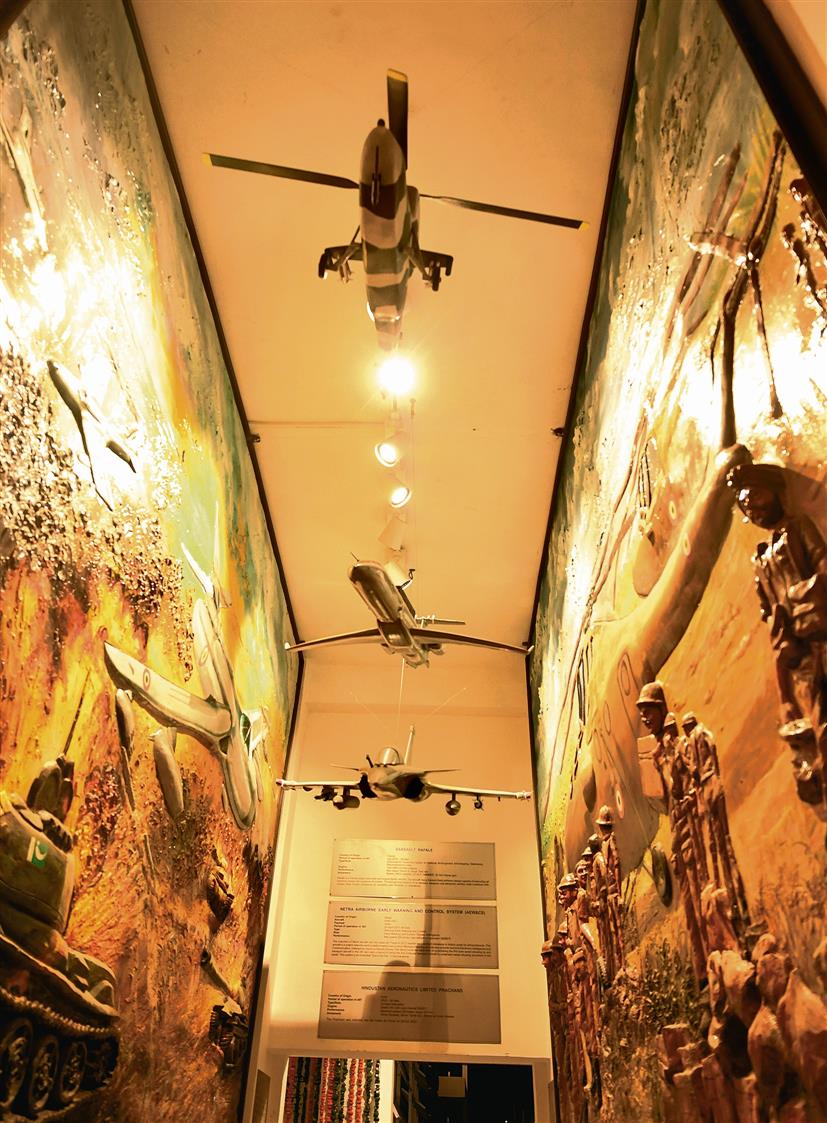
Advertisement
A wall is dedicated to Patiala-born Wing Commander Rakesh Sharma, who was the first Indian to travel to space, making his epochal journey in a Russian Soyuz T-11 in 1984. Interestingly, the wall also carries the picture of Air Commodore Ravish Malhotra, who was also shortlisted along with Wing Commander Sharma to go to space.
Models of the Pralay missile, Smart Anti Airfield Weapon, Brahmos (aerial version), Hammer Air to Surface Missile, Laser Guided Bomb, and Astra missile are displayed in a row.
Including space outside the gallery, the heritage centre is spread over 40,000 square feet. “However, there is still space left for expansion,” says Lamba.
Director Tourism, Chandigarh Administration, Rohit Gupta, says, “One aim of setting up the museum is to feature the exploits of IAF so the youth could identify with it. The other is to give a first-hand account of how things are.”
“Press Building is a heritage building,” recalls former Administrator Badnore. “Earlier, the printing press used to function but later, it was not in use. We were planning to have vintage cars here, but it didn’t work out. Then the setting up of an IAF heritage centre was proposed. The IAF responded positively. It has come out so nicely, better than what I thought. The region has youngsters who want to join the armed forces. This centre will be a great inspiration.”

LIFE, at times, provides a humbling experience. We were driving from Brussels to Paris. To avoid the tedium of the autoroute, we took the national road. The weather suddenly turned nasty, with heavy rain and lashing winds. Passing through Compiegne, 70 km northeast of Paris, as I crested a flyover, the car engine gave an unhealthy jerk and died. I failed to revive it despite repeated attempts.
Leaving my wife in the car, I walked towards a roadside telephone booth. I was struggling to open the umbrella against the gale when a car coming from behind screeched to a halt. ‘You aive a probleme?’ the man at the wheel asked with the typical French thriftiness with the letter ‘h’.
As I nodded, he asked me to get in. I sat in the rear seat beside his fishing gear, while the man and his female companion were in the front.
Some 5 km outside the town, he stopped in front of a garage. Asking me to keep sitting, he ran inside through the stormy rain. Recalling the unhappy experience of a friend who had been conned in similar circumstances, my thoughts turned negative. I wondered why he had come this far when other garages were there in the town itself. Did he have some interest in this garage? Maybe he owned it, I said to myself.
I saw him talking to a person in greasy overalls, though I could not hear their conversation. I read a meaning in each gesture and prepared myself for a rip-off.
Coming back, he said, ‘We will aive to go to another garage.’
We did a U-turn and drove back past my car into the heart of the town. He found a bigger garage and repeated the drill of going inside while asking me to remain seated. ‘Maybe he did not get a lucrative cut earlier?’ my pessimistic thinking continued. I could not help touching my pocket to feel the wallet.
‘The manager says he will get your voiture (car) repaired,’ said the man, now completely drenched. He opened the car door for me to alight. I tried to detect a hint of triumph in his smile.
As I walked up to the manager, I heard the car behind me start and drive away. ‘Where has he gone?’ I asked. The manager looked at me curiously. ‘Don’t you know him?’ I enquired.
‘No, monsieur, he does not belong to this town. He was only driving through when he noticed that you needed help.’
‘But…?’ and the words failed me. I ran out in the rain, but he was gone. I suddenly felt dwarfed, seized by guilt over my evil thoughts, made worse by the realisation that I would never be able to trace and thank the angel; I had not even noted down his car’s registration number.
Later, when I shared my thoughts with her, my wife remarked, ‘The world is full of good people.’
‘It indeed is,’ I said. ‘The really “good” ones don’t even seek anything in return.’

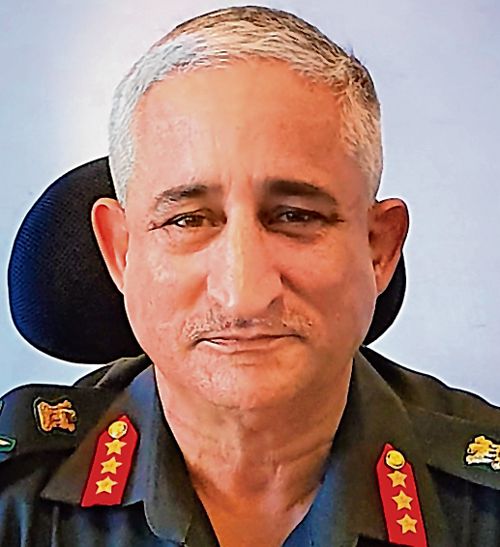
THE Doklam plateau, which was the scene of a 72-day tense standoff between the Indian Army and the Chinese PLA in 2017, has been in the news this year. Bhutanese PM Lotay Tshering said in an interview to a Belgian publication in March that China was an equal party to the boundary dispute in this region, regarding the location of the tri-junction between India-China-Bhutan. This would have seemed innocuous enough, were it not for the fact that by tacitly accepting the need to trilaterally discuss the Chinese claim lines in its south-west region neighbouring India, Bhutan is treading on India’s core security concerns. The Chinese have laid claim to areas up till Mount Gyemochen in south-east Sikkim. This lies around 8 km further south of Batang La, the present tri-junction, and the claim covers the entire area of the Doklam plateau, comprising 60-odd square km of undulating terrain, which lies in the Haa district of Bhutan. Any shifting of the tri-junction south will not only make Doklam Chinese territory, but their boundary would then rest on the Jampheri ridge, the highest feature in this area after which the mountain ranges roll southwards for 40 km through Bhutan, before reaching the border with India, on the northern edge of the Siliguri corridor.
Incidentally, the only settled border along the entire stretch of 3,488 km of the LAC was in Sikkim. The joint statement issued during Chinese premier Wen Jiabao’s visit to India in 2005 clearly stated that China recognised “Sikkim state of the Republic of India”. Wen even handed over an official map of the People’s Republic of China to the Indian PM, accepting the legitimacy of the India-China border in Sikkim. The 220-km-long boundary in this sector starts at the tri-junction between India, Bhutan and China, at Batang La in south-east Sikkim and then runs north along the Dongkya range. It is this point at Batang La which China now wants to push further south, thereby claiming the entire Doklam and getting closer to India’s Siliguri corridor, which connects the country to its North-East.
In June 2017, when the Indian Army crossed the watershed at Doka La into Bhutanese territory to physically stop the PLA from constructing a road towards the Jampheri ridge, the Bhutanese government had been somewhat subdued in their denouncement of the Chinese intrusion. China has also occupied areas in western Bhutan across the Amo Chu river and settled three border villages, thereby broadening the tip of the Chumbi Valley, which lies between India and Bhutan. Surprisingly, the Bhutanese government has denied that there are Chinese installations within its territories.
Apparently to soothe frayed tempers in Delhi, the King of Bhutan, on a three-day visit to India in the first week of April, made all the politically correct gestures and the joint statement reiterated that “India and Bhutan share an exemplary relationship, which is characterised by trust, goodwill and mutual understanding”.
Looking beyond this, it is apparent that Bhutan sees building bridges with China as imperative. Its Foreign Minister mentioned an early resolution of border disputes with China, on the sidelines of the Indian Ocean Conference at Dhaka, on May 13. It may be more than willing to trade off the Doklam territory, including some pockets east of Amo Chu where Chinese villages have come up, in exchange for the much larger disputed areas of Pasalmlung and Jakarlung, totalling about 500 sq km, along its northern border with China. It may also be looking at greater economic benefits by further opening relations with China. The Bhutanese monarchy has mostly been pro-India in its public stance. However, given the internal complexities of the ‘Hermit Kingdom’, where the influence of the monarchy and the monastic order may be waning somewhat, the aspirations of an increasingly democratic Bhutan cannot be wished away.Advertisementhttps://c59ac78e42d4cab5b720b09433cf0059.safeframe.googlesyndication.com/safeframe/1-0-40/html/container.html
Still, India has a lot going for it in this part of its geography. The threat to the Siliguri corridor due to the sudden decrease in width as the Indian territory extends eastwards, with Nepal, Bangladesh and Bhutan hedging in this area from the west, east and north, is overhyped. The shortest expanse is 20 km between the border checkpoints of Kakarbhitta on the India-Nepal border and Changrabandha on the India-Bangladesh border. The width of the Indian territory between Bhutan and Bangladesh is 43 km at its narrowest. From Jampheri, in south Bhutan, it is over 40 km of undeveloped mountainous terrain till the Indian border.
The Indian territory may well be visible from Jampheri through high-powered optical devices, but the PLA can observe it just as easily from much further north through satellites and high-altitude drones and engage it with various long-range systems, if required.
The real Indian strength lies in the umbilical economic linkages and it would be difficult if not impossible for China to replicate India-Bhutan ties in this aspect. Power from Chukha, Tala, Mangdechhu and other hydel projects built with Indian assistance is generated mostly to India, yielding a steady source of income to Bhutan. Further, the Bhutanese Ngultrum and Indian Rupee are tied at an (artificial) exchange rate of 1:1, administered by the Indian RBI. This by itself is a huge economic boost to Bhutan. Easy access to large Indian urban habitations in the Siliguri region, business centres, trade routes and most importantly, the land link between eastern and western Bhutan through the Indian territory, are vital for it. Any diminution in this economic linkage will severely impact Bhutan. China cannot match any of the above win-win factors but is following a predatory economic diplomacy. Then again, the Bhutanese are nobody’s fools and quite shrewd in making out what is good for them.Advertisement
The Chinese ingress into western Bhutan, whether by tacit understanding or otherwise, may not immediately threaten the Siliguri corridor. However, this possibility necessitates re-calibration of the Indian Army deployment on the Bhutan border, with the area south of Jampheri requiring increased attention. The armed forces will surely have come to grips with this matter.
What India needs to build upon is its positive relationship with Bangladesh, so that it becomes a permanent feature beyond political regime changes. It needs to increasingly work on obtaining free transit facilities through northern Bangladesh, adjacent to the Siliguri corridor, and seek to jointly develop communication infrastructure in this area, and also transport corridors, gas and oil pipelines and rail networks.
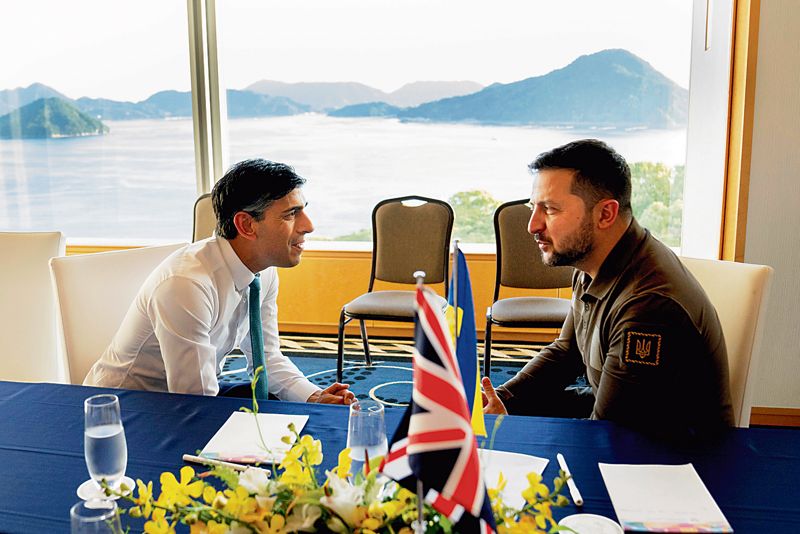

THE fatigue over the war in Ukraine, which will complete 15 months on May 24, is suddenly over for many people who had become tired of the same headlines and images, as often happens in conflicts which seem to have no end in sight.
The fatigue is over not only because of spectacular claims by Ukraine to have shot down 29 out of 30 Russian missiles fired at Kyiv in one night, including the ‘unstoppable’ Kinzhal hypersonic ballistic weapon and similar others fired from land, sea and air. Ukraine’s claims have been upheld, at least partially, by some photos and videos of missiles being shot down over sea and against the backdrop of Kyiv’s skyline of historic, domed Orthodox churches. The shots have been riveting.
The war fatigue got a pause when Volodymyr Zelenskyy, the President of Ukraine, got out of round-necked, collarless T-shirts, which had become his trademark dress since the start of the war. Last Friday, he landed in Jeddah in a polo shirt with army shades, a very welcome sartorial change. As a concession to conservative Arab sensitivities in dress code, Zelenskyy’s polo shirt had long sleeves and covered every bit of skin, except his palms, head and face. It was appropriate etiquette at the Arab League Summit, a welcome change from his speech to the 77th UN General Assembly last September in a creasy Henley shirt with round neckline and placket sleeves — an affront to protocol and diplomatic decorum.
Defying Russian air attacks and appearing with immaculately dressed world leaders on the streets of his capital in those almost shabby T-shirts may have been Zelenskyy’s way of making a statement, but after more than a year of it, such antics by a sitting President had become tiresome. The President showing his biceps may or may not boost the confidence of Ukrainians who have been living dangerously, but for many people across the world, it is not in good taste.
The recent changes did not come by accident. Slowly, but surely, Ukraine is beginning to give as good as it gets from Russia. Ukraine is no longer as much of an underdog that it was when the war started. Rescuing itself from overnight weapons, which were hitherto considered invincible, is only part of the new confidence manifesting in Kyiv.
Zelenskyy’s machinery appears to have succeeded in activating its thousands of sleeper cells, which have always existed inside Russia. Nearly six million ethnic Ukrainians live in Russia, according to reliable statistics, a leftover of history from centuries of mutual integration through proximity and politics. In any such circumstance, there would be thousands of people who are willing to act as a fifth column for their original fatherland. Reports have emerged that the unmanned drones which were shot down over the Kremlin sky at the beginning of this month were actually fired by this fifth column from inside Russia. That is how they avoided detection, which would have occurred had they been on flight from Ukrainian territory. Increasing acts of sabotage and destruction to property in Russia also point to successes in activating Ukrainian sleeper cells within Russia. The situation is similar to cross-border terrorism that is exported by Pakistan to India.
It is very likely that the tide may be turning for Ukraine in the war because of the sophisticated, state-of-the-art weaponry that Zelenskyy has finally received from his allies in the West. It is likely that secretly, North Atlantic Treaty Organisation (NATO) personnel are operating these high-tech defensive equipment such as anti-missile batteries which have reached Kyiv. Greater precision in hitting Russian military targets also points to NATO involvement.
It is to match a turn in the tide of war that Zelenskyy is getting an image makeover. He arrived for the Group of Seven Summit in Hiroshima (May 19-21) in a deep brown windcheater with a hood. Not yet in a jacket with a tie. Two days before he landed in Jeddah in his polo shirt, his wife, First Lady Olena Zelenska, spoke at one of Seoul’s highest-profile media events dressed in a thick, partially military-style green dress that extended from her lower neck to well below her knees. Gone was her casual appearance familiar to all in Kyiv. When she appeared later that day to sign a cultural exchange agreement with the Seoul Metropolitan Government, she was the height of elegance in a stunning white shirt and contrasting black pants with an appropriate waist belt and only one piece of jewellery. Juxtaposed with former UK PM Boris Johnson, with his tousled hair and ill-fitting suit, at the 14th annual Asian Leadership Conference organised by South Korean newspaper The Chosun Ilbo, Zelenska appeared more elegant than ever. She made an impression on South Koreans by pointedly asking their President Yoon Suk Yeol only for non-lethal military assistance for her country.Advertisementhttps://de12c345d1706f68fa5c404cd2e8712f.safeframe.googlesyndication.com/safeframe/1-0-40/html/container.html
Zelenskyy went on a diplomatic blitz all over Europe this month, marking a change in Ukrainian leaders’ earlier policy of mostly hunkering down at home and getting counterparts to meet him in Kyiv. He has visited Finland, France, Germany, Italy, the Netherlands and the UK since May 1. The most emotionally powerful visit was to the Vatican in mid-May.
Prime Minister Narendra Modi would not have given the time of day to Zelenskyy before February last year because Ukraine was an unstable country that was of no use to India. Nothing could be done there without greasing the right palms in any case. Besides, successive governments in Kyiv have been trying to sell arms to Pakistan for use against India. When Modi agreed to meet Zelenskyy in Hiroshima during his ongoing trip to East Asia, it was a recognition that after 15 months of war, Ukraine’s diplomacy was making advances. It is wishful thinking in some quarters that it was part of any peace plan from New Delhi, even as India recognises that it has to be nimble and make frequent adjustments to its approach to the Ukraine war.

London, May 22
An Indian-origin Sikh councillor has made history after being appointed as the new Lord Mayor of Coventry, a city in the West Midlands, England.
As a Lord Mayor, Punjab-born Jaswant Singh Birdi will be the Chairman of the City Council, and as Coventry’s first citizen, he will be the non-political, ceremonial head of the city.
“I am so proud to become Lord Mayor of my adopted home city. It has given so much to myself and my family over the years and I will be honoured to show why I love it so much and to promote the city and the wonderful people who live here,” Birdi said in a statement.
Birdi was presented with the Chains of Office, worn as an official regalia by the Mayor, at an annual general meeting of Coventry Cathedral last week.
“As a Sikh, it also means so much that I will be wearing the Chains of Office and the turban. It will help show what a happy multi-cultural city we have and maybe inspire others as well,” he said.
Born in Punjab, Birdi moved to Coventry 60 years ago and has spent 17 years as a councillor in the city, representing Bablake Ward for the past nine years, following two terms of office in the 1990s in the Hillfields Ward.
After having served as Deputy Lord Mayor for the past 12 months, he succeeds Councillor Kevin Maton in the role.
He grew up in a village in the Indian part of Punjab and also spent time as a child in Lahore and West Bengal, as his family travelled for employment.
In the mid-1950s Birdi emigrated with his parents to Kenya in East Africa, where he had his primary and secondary education, and emigrated to the UK in the 60s to carry on with his further education.
Apart from being a councillor, he has been actively involved in setting up religious, social and community projects in the city.
He has named his chosen charities for the year as the Muscular Dystrophy charity, the Coventry Resource Centre for the Blind, and University Hospitals Coventry and Warwickshire Charity.

Bijapur, May 22
Two commandos of the Central Reserve Police Force’s jungle warfare unit CoBRA were injured in an encounter between security forces and Naxalites in Chhattisgarh’s Bijapur district, police said on Monday.
Two to three Naxalites also received bullet injuries in the gun fight which took place at around 8 pm on Sunday in Bijapur, located around 400 km from the state capital Raipur, they said.
A joint team of the District Reserve Guard and the CRPF’s Commando Battalion for Resolute Action (CoBRA) launched a search operation from Pusnar camp on Sunday evening after getting information about an improvised explosive device (IED) planted between Pusnar and Hiroli villages under Gangaloor police station limits, an official said.
At around 8 pm, the gun battle broke out between the security personnel and Naxalites in the area.https://461e04da7390369e2ec343d80b6850b0.safeframe.googlesyndication.com/safeframe/1-0-40/html/container.html
After a brief exchange of fire, Naxalites escaped into the dense forest, he said.
Constables Nakul and Mohammad Shahid, belonging to CoBRA’s 202nd battalion, suffered injuries on their hands and legs in the face-off, the official said.
They were were shifted to the Bijapur district hospital and their condition was stated to be out of danger, he said.

























































